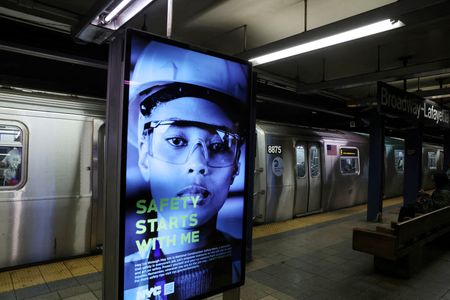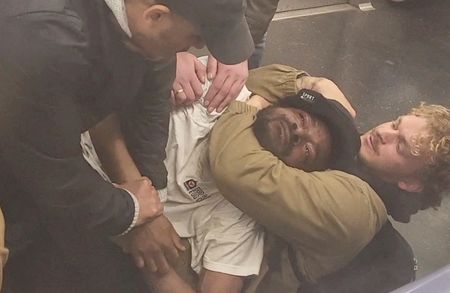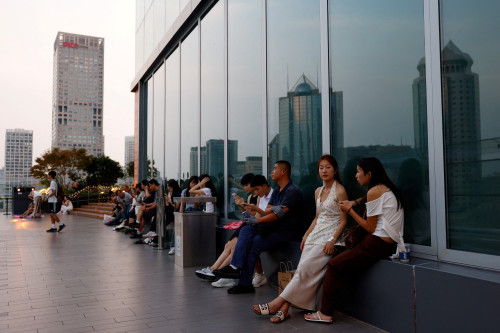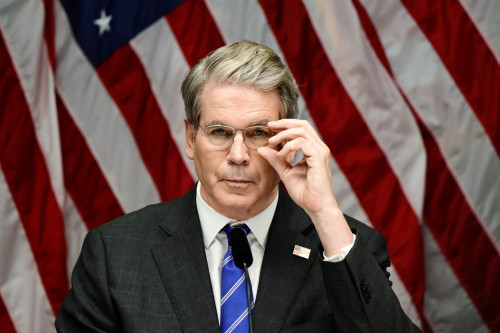By Julia Harte
NEW YORK (Reuters) – A fierce debate among New Yorkers over whether a former U.S. Marine was justified in choking an agitated homeless man to death on a subway car last week has renewed focus on a perennial question: Just how bad is crime in the nation’s biggest city?
Following the killing, many city residents have said they feel threatened by homeless and mentally ill people in the transit system. That population surged during the pandemic as New Yorkers with homes avoided the subway, and those with no place to live sought refuge outside the confines of shelters.
The overall subway crime rate spiked in April 2020, as COVID-19 gripped New York, but city statistics show the daily rate fell back to pre-pandemic levels by mid-2021. There were roughly two major felonies per million subway customers in the first three months of 2023, the same rate as the first three months of 2020, according to data from the Metropolitan Transportation Authority (MTA).
“The numbers don’t jibe with the fear,” said Christopher Herrmann, an associate professor at John Jay College of Criminal Justice and former crime analyst supervisor at the New York Police Department.
Given that 3 million to 3.5 million people ride the subway every day, Herrmann noted, any given rider is highly unlikely to experience a major crime. “Those are lottery-winning kinds of numbers,” he said.
Felony assaults have remained slightly more frequent in the subway than before the pandemic, with 132 in the first quarter of 2023 compared with 110 in the first quarter of 2020, city data shows. Robbery and grand larceny, the other most common types of major subway crime, dropped during the same period.
But the data does not show how often the assailants or victims are homeless, according to Herrmann. Subway crimes get reported more than above-ground incidents, he said, because there are usually more witnesses.
Still, rider advocates and former transit employees say, New York subway passengers encounter mentally ill and homeless people more often than other Americans, making them feel they are in greater danger.
‘PEOPLE ARE CONFLATING HOMELESSNESS WITH CRIME’
Last week’s altercation occurred after 30-year-old Jordan Neely boarded a train, threw his jacket down, and yelled that he was hungry and ready to die, according to local news reports. A video showed former Marine Daniel Penny, 24, with Neely in a choke hold on the floor of the train for more than three minutes. Penny is white and Neely was Black, and the incident sparked protests against what some characterized as an act of “white vigilantism.”
“To feel you’re trapped in a car with somebody who is irrational, and that until you get to the next stop you can’t get out — that’s very frightening,” said Dorothy Moses Schulz, an adjunct fellow at the Manhattan Institute think tank and a retired commanding MTA police officer at Grand Central Terminal, one of the city’s main transit hubs.
“The problem is people are conflating homelessness with crime,” said Danny Pearlstein, policy and communications director at Riders Alliance, a grassroots organization that advocates for city subway reform. “People see homeless people and are afraid, and don’t know what will happen next.”
A growing minority of customers were satisfied with subway safety in the last two months of 2022, according to an MTA survey.
Overall, 42% of respondents said they were satisfied with “personal security on trains,” a 9 percentage-point increase from a spring survey. Only 30% of respondents expressed satisfaction with the level of “people behaving erratically on trains,” though that was up 7 percentage points from spring 2022.
Candidates in recent New York elections have fed the perception that crime is rampant. Republican Lee Zeldin highlighted grisly city subway crimes in last year’s gubernatorial election, prompting Democratic Governor Kathy Hochul to also focus on anti-crime policies in her campaign.
Several high-profile attacks on subway passengers last year, particularly Asian Americans, led New York City Mayor Eric Adams in February 2022 to announce an increase in police patrols and an expansion of outreach to the mentally ill in the transit system, citing rising homelessness after the pandemic.
A monthly city survey found that the portion of respondents who thought there were the “right amount” of uniformed police officers in the subway grew from roughly one quarter to nearly half in the five months after the program was launched.
(Reporting by Julia Harte; editing by Jonathan Oatis)






